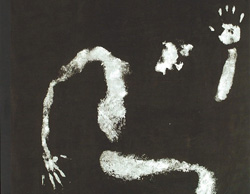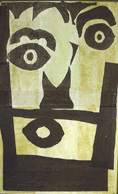The Living Museum

Man in a box (black); latex and acrylic on canvas, by Issa Ibrahim, 2001

Self Portrait, tissue on cardboard, by John Tursi, 1998
Some objects displayed at the Living Museum are manifestations of the mind in a psychotic state. Some are intensely political, some amusing. There is no common denominator. Some artworks were created using outdated kitchen equipment left on the premises, some were conceived on the basis of found objects.
John Tursi, for example, uses about anything he can get his hands on - tree limbs, a tiny Santa hat, crayons, and string. His delusional framework involves sexual fantasies which are a fertile source for whimsical and erotic drawings. According to his delusion, which is fixed in the sense that medication will not change it, there exists a book, somewhere out there in space, containing all of his art, down to the very last detail; the Hungarian ma-thematical genius Paul Erdoes argued for a similar notion of a book in heaven, containing nothing but mathematical solutions. Tursi always refers to his inner book filled with infinite streams of colorful fantasies that permit us access to a universe otherwise closed to the uninitiated. Mr. Tursi is an outpatient. Because of his successes as an artist, he can afford to live in a regular co-op. He comes to the hospital every day. An exhibit of his artwork took place in 1999 in a gallery for Outsider Art in SoHo, Manhattan.
Issa Ibrahim is a painter, singer, poet and history buff. Born in 1965 to a black musician father and a white mother, his artwork is inspired by his African American roots. Sophisticated and outspoken, he describes himself as being in a constant state of limbo between two worlds. "My life is a story of mental illness and addiction. I have been in Dante’s inferno: I was in jail before they put me in a hospital for the criminally insane. I first came in as a paranoid schizophrenic, then I suffered from drug induced psychosis. My artwork has helped my ordeal, painting is my catharsis."
Austrian Information conducted the following interview with Dr. Marton:
How is the Living Museum organized?
Our attitude is based on need, not on democracy or equity. It is more like a family structure in that people get what they need and not what they deserve. One of the big problems is that the mentally ill are often treated like bad children. They are approached in a moralistic way, and it doesn’t work. People don’t misbehave in a mentally ill way because they are bad. It’s a brain disease. Most mentally ill people are over-socialized by the time I get my hands on them. The rules are really self mposed. If you own the place, you work along internalized rules - and it has worked fantastically. Nothing negative ever happened here. People start as inpatients and progress to living in the community. They feel better when they think of themselves as artists instead of patients.
A longstanding argument in psychology is whether creative genius is somehow tied to mental illness. Is there a link?
There is the question of whether van Gogh would have been a great artist had he not been mentally ill. I think that mental illness is an asset in art. You don't have to be mentally ill to be a great artist, but you definitely have to work very hard to arrive at a state of mind which is a given for the mentally ill. The point is that art is not going to take away your illness. But it builds on the symptoms of mental illness. Great art really occurs in the domain where schizophrenic processes often occur. Also, creativity comes when people are less inhibited by the rules of society. They are completely free to express themselves artistically.
A psychiatrist at Gugging once said the number of truly gifted artists among the mentally ill was about the same as among other people; that is, very, very small. Do you agree?
I think that the idea of talent is overrated. It's five percent talent and ninety-five percent sweat. The traditional definition of art, of its quality and value, went out through the window with Marcel Duchamp. I am a fan of Gugging, but they are much more conservative. We pay homage to Andy Warhol's Factory, to Duchamp. We do much more applied modern art, conceptual art.
Explain the difference between what happens at the Living Museum and traditional art therapy. The Living Museum is about art and not about therapy. In art therapy, the artworks are interpreted in terms of the patient’s life. Self-definition of the mentally ill is incredibly self-destructive because of societal scorn and because they are stripped of every other aspect of their humanity. Whatever identity they have is reduced to that of a mental patient. The ambition of the Living Museum, however, is to change the identity from that of a mental patient who is hospitalized and locked up, to that of an artist. Public exhibitions are regularly organized, and our artists occasionally exhibit off-site. I choose the location, and people come to see their work. Apart from that, I try to get them a job, whether they are painters, video artists, musicians or writers. Suddenly, the disadvantage of their existence, which is time and boredom and waiting - that’s the reality of mental illness - turns into an asset: "Oh my God, I have time to paint!" I truly believe that what we do at the Living Museum is the solution for psychiatry. I am not against psychoactive drugs, because they work. However, the Living Museum takes it one step further: The patient transforms suffering and empty time into art through the creativity released by his illness.
